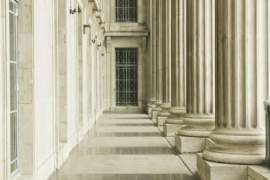
Stenography Explained

What is Stenography?
Stenography is the practice of legal transcription of speech into text taking place within a court hearing or trial performed by Court Reporters, who are licensed and certified professionals. Stenography positions are classified as legal occupations requiring earned certifications from accredited institutions.
The mastery of Stenography requires the ability to produce accurate and expedited legal transcription of speech within a legal venue, which is accomplished through the proficiency in shorthand, stenography, and typing skills.
Stenography Equipment
Stenography or ‘Court Reporting’ involves the following methodologies enacted in order to undertake the transcription of oral speech into textual format:
Stenotype
A Stenograph machine – also called a Stenotype machine – is a machine resembling a typewriter that is used for manual Stenography for the purpose of legal transcription. In contrast to traditional typewriters, a stenograph machine contains only 25 keys and does not operate on a traditional keyboard format such as ‘QWERTY’.
Legal stenotypes include features allowing a court reporter to transcribe common phrases and articles rather than individual letters and characters.Chording is a typing method utilized within the field of Stenography allowing court reporters to adequately and accurately transcribe legal hearings through the pressing of multiple keys in a single stroke.
Chording allows stenographers to transcribe whole words in lieu of typing the word in a ‘letter-by-letter’ fashion, which results in stenography taking place in a ‘real time’ setting.
Voice Recognition Technology
Stenography undertaken through the utilization of voice recognition technology relies on the digital processing of the distinctive and specific nuances latent within the human speaking voice. However, in order to ensure the accuracy of this particular technology, an extensive regimen of proofreading and editing is may be required.
Who Regulates Stenography?
Arguably the most common certification with regard to the field of Stenography is that of a Registered Professional Reporter (RPR). This certification must be granted by an educational institution accredited by the National Court Reporters Association (NCRA).
The NCRA enacts the methodology and ideology expressed within The Phrase Book of Pitmanic Shorthand, which expressed the requirements and processes latent within the production of authorized transcription of both legal and medical proceedings.
The National Court Reporters Association is responsible for both the regulations and oversight of the certifications that are granted to individuals who desire to gain employment through the field of Stenography. The NCRA began as an institution specializing in shorthand with regard to the provision of expedited and accurate transcription of events.
Stenographer Certification
In order to be awarded certification as a Registered Professional Reporter (RPR), a student of stenography will be required to satisfy the following requirements:
Examination
The Court Reporter Written Knowledge Test is an examination used to gauge the skill of an individual stenographer student. The individual stenographer will be required to display the ability to produce a transcription of events, proficiency in the operation of a stenograph machine, and a review of background knowledge and professional acumen.
Typing
The ability to produce an expressed amount words within a finite period of time is required. The classification of which is also known as ‘words per minute’, or ever ‘wpm’, these requirements vary with regard to the nature of the testimony:
Literary Legal Transcription (180 wpm);
Jury Transcription (200 wpm);
Examination-based Testimony (225 wpm).



















